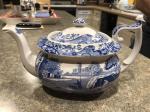

These small plates are many times mistaken for dessert plates. These are knife rests and were intended to keep your butter knife sanitary in case you wanted more of the (shared) butter throughout the meal. These can be made in china, crystal or in silver and often look like tiny barbells. They are perfect for twirling pasta around on one’s fork and for piling up the sauce, but this type of dish is not always a standard part of tableware sets these days. If you come across a bowl too shallow for soup and too rounded for a decent sized sandwich then that is a pasta bowl. These might be shared across the table or placed at each setting in finer households. But, in the old days there may have been a salt cellar instead: a tiny pot with a tiny spoon. Most of us are used to regular old salt and pepper shakers being on the table at meal times. Special occasions or upper class households might have even warranted orange blossom water or rosewater in the bowls! Via/ Wiki Commons Salt Cellar These small bowls were filled with water and members of the meal party would daintily dip their fingers in to clean them off. Via/ Flickr Finger Bowlīetween courses and before the meal started, formal meals included the use of finger bowls. In the 20th century some china sets would have come with matching casserole dishes which also had lids. This two handled serving dish often had a platter underneath to collect spills and a lid to keep food hot.

Most of us would know a gravy boat if we saw it in person, but for auction descriptions it’s useful to understand some of the other names this popular serving dish goes by. This is the fancy French word for a gravy boat. Quietly using a spoon came later and now soups are considered one of the “naturally” messier foods out there. It was once considered polite to gently sip one’s soup. If it looks like a teacup with two handles and it fits nicely into a matching saucer, then this item is a soup bowl.

Here is some information on the more obscure china tableware pieces from the past that most people today will have not had much chance to use. On the other hand, you might not even know what those pieces of china were originally used for. On the one hand you might find some really inexpensive pieces of beautiful china. Going thrifting or antiquing has its ups and its downs.


 0 kommentar(er)
0 kommentar(er)
